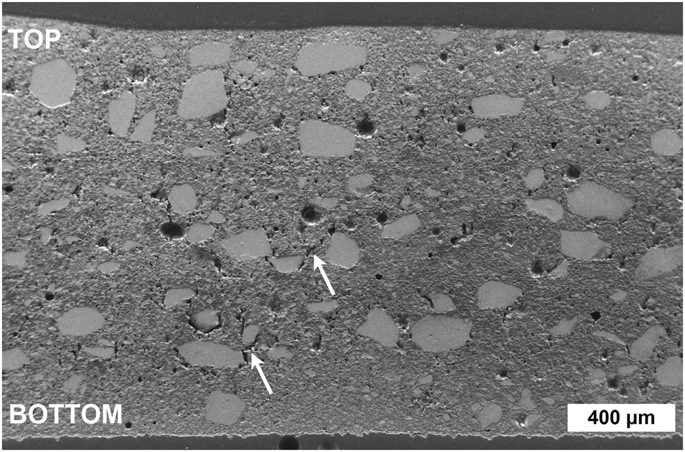In a paper entitled “3D printing dielectric ceramic without a sintering stage,” a group of researchers describes how they created dielectric ceramic parts through 3D printing, while circumventing the usually necessary sintering phase. Conventional sintering is both time- and energy-consuming, they explain. Normally, the ceramic powder is packed with organic additives under compression, followed by binder burnout and sintering at high temperatures. The process results in the densification of the powder into a solid piece due to thermally assisted mass transport. The time and energy consumed by the process is only one of the drawbacks – it’s also difficult to control shrinkage, which means that additional shaping of the part may be needed.
 Powder bed fusion is the only single step process for the additive manufacturing of ceramics. In the paper, the researchers focused on material extrusion. They created a 3D printable paste by mixing the water soluble material lithium molybdate (Li2MoO4) with water.
Powder bed fusion is the only single step process for the additive manufacturing of ceramics. In the paper, the researchers focused on material extrusion. They created a 3D printable paste by mixing the water soluble material lithium molybdate (Li2MoO4) with water.
“Lithium molybdate (Li2MoO4) is a non-toxic dielectric ceramic material, which has been studied for corrosion inhibition and moisture sensing applications as well as a scintillator material for detecting some rare nuclear processes, anode material for Li-ion batteries in modified form, and catalyst for methane oxidation,” the researchers explain. “For microwave devices, Li2MoO4 is of interest because of its beneficially low dielectric loss in addition to its low sintering temperature of 540 °C. However, Li2MoO4 is water-soluble, enabling component manufacture at temperatures as low as room temperature.”
 In this method, known as room temperature fabrication or RTF, the lithium molybdate powder was moistened with water, and partial dissolution of the material formed an aqueous phase which aids particle packing and densification during the compression and avoiding shrinkage. The dissolved lithium molybdate recrystallizes during drying due to water evaporation, which cab be sped up by heat treatment. Because no sintering is required, there is no formation of extra phases or heat expansion mismatch.
In this method, known as room temperature fabrication or RTF, the lithium molybdate powder was moistened with water, and partial dissolution of the material formed an aqueous phase which aids particle packing and densification during the compression and avoiding shrinkage. The dissolved lithium molybdate recrystallizes during drying due to water evaporation, which cab be sped up by heat treatment. Because no sintering is required, there is no formation of extra phases or heat expansion mismatch.
Once a viscous mixture of solid ceramic particles and saturated aqueous phase was formed, sample discs were 3D printed using a low-cost syringe-style 3D printer. The samples were printed with smooth surfaces, the paste extruding successfully with good shear behavior. The microstructure of the printed parts was analyzed, as were the densities and dielectric properties. The water content in the mixture was kept as low as possible to avoid porosity, as well as the cracking and shrinkage that can occur with a longer drying time.
“The consolidation and densification of the printed parts occurred during both printing and drying of the paste due to extrusion pressure, capillary forces, and recrystallization of the dissolved Li2MoO4. Complete drying of the paste was ensured by heating at 120 °C,” the researchers state. “The microstructure showed no delamination of the printed layers. Relatively high densities and good dielectric properties were obtained, especially when considering that no sintering and only pressure from the extrusion was employed. This approach is expected to be feasible for similar ceramics and ceramic composites.”
Authors of the paper include Maria Väätäjä, Hanna Kähäri, Katja Ohenoja, Maciej Sobocinski, Jari Juuti and Heli Jantunen.
Discuss this and other 3D printing topics at 3DPrintBoard.com or share your thoughts below.
Subscribe to Our Email Newsletter
Stay up-to-date on all the latest news from the 3D printing industry and receive information and offers from third party vendors.
You May Also Like
3D Printing Unpeeled: New Arkema Material for HP, Saddle and Macro MEMS
A new Arkema material for MJF is said to reduce costs per part by up to 25% and have an 85% reusability ratio. HP 3D HR PA 12 S has been...
3D Printing News Briefs, January 20, 2024: FDM, LPBF, Underwater 3D Printer, Racing, & More
We’re starting off with a process certification in today’s 3D Printing News Briefs, and then moving on to research about solute trapping, laser powder bed fusion, and then moving on...
3D Printing Webinar and Event Roundup: December 3, 2023
We’ve got plenty of events and webinars coming up for you this week! Quickparts is having a Manufacturing Roadshow, America Makes is holding a Member Town Hall, Stratafest makes two...
Formnext 2023 Day Three: Slam Dunk
I’m high—high on trade show. I’ve met numerous new faces and reconnected with old friends, creating an absolutely wonderful atmosphere. The excitement is palpable over several emerging developments. The high...
































